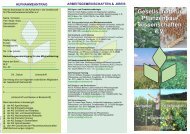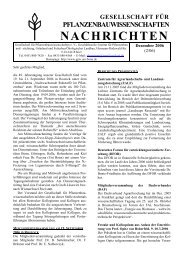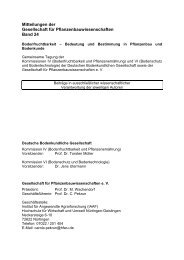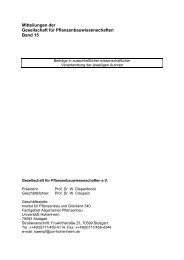Mitteilungen der Gesellschaft für Pflanzenbauwissenschaften Band 23
Mitteilungen der Gesellschaft für Pflanzenbauwissenschaften Band 23
Mitteilungen der Gesellschaft für Pflanzenbauwissenschaften Band 23
Erfolgreiche ePaper selbst erstellen
Machen Sie aus Ihren PDF Publikationen ein blätterbares Flipbook mit unserer einzigartigen Google optimierten e-Paper Software.
Mitt. Ges. Pflanzenbauwiss. <strong>23</strong>: 194 (2011)<br />
(How) do polyamines mediate stress tolerance in barley?<br />
Nancy Nowak, Heidrun Beschow, Liane Freitag and Edgar Peiter<br />
The Plant Nutrition Laboratory, Martin-Luther-Universität Halle-Wittenberg, Halle. E-Mail: nancy.nowak<br />
@landw.uni-halle.de<br />
Introduction<br />
Worldwide, drought is the main yield-limiting factor in crop production. Drought<br />
resistance is therefore a major goal for crop research. Polyamines play a central role<br />
in abiotic stress tolerance of plants in general and drought tolerance in particular<br />
(Alcazar et. al 2006). Common polyamines in plants are putrescine, spermidine and<br />
spermine. Recent studies show that spermine seems to play a specific role in stress<br />
tolerance. The aim of this project is to investigate the role of spermine and its<br />
structural isomer thermospermine in drought stress tolerance of barley. We<br />
hypothesise that polyamines modulate abiotic stress-related Ca 2+ signals, which in<br />
turn would affect stress tolerance mechanisms.<br />
Materials and Methods<br />
Barley (Hordeum vulgare L.) plants were grown in a growth chamber at 22°C, 65%<br />
relative humidity and a photoperiod with 16h light and 8h darkness. Genes encoding<br />
proteins possibly mediating of the synthesis of spermine and thermospermine in<br />
barley were identified and full-length cDNA sequences were obtained according to<br />
standard methods. For overexpression and RNAi-induced silencing of those genes<br />
we cloned cDNAs into the binary vector pLH6000. The vector was transformed into<br />
Agrobacterium tumefaciens by electroporation. Genetic transformation of barley was<br />
performed as described by Tingay et al. 1997. For cell culture experiments we<br />
established a new suspension culture from callus. Callus and cell cultures were<br />
grown in modified Murashige and Skoog medium. Pharmacological experiments on<br />
tissue cultures and intact plants were carried out on hydroponically-grown plants.<br />
Results and Discussion<br />
For the reverse genetic analysis of spermine synthases in barley, an immature<br />
embryo-based transformation protocol has sucessfully been established in the<br />
laboratory, with transformation efficiencies of around 30%. Initial pharmacological<br />
experiments on whole plants have yielded the unexpected result that application of<br />
spermine to the root medium affected the plant’s osmotic stress tolerance in a<br />
negative way. Current examinations indicate that this effect may have been caused<br />
by bacterial degradation products. Also, in first suspension culture experiments the<br />
application of the polyamine spermine caused a diminished cell growth. For a better<br />
un<strong>der</strong>standing of polyamine action in barley the regulation of stress-related [Ca 2+ ]cyt<br />
signalling by polyamines is currently being analysed.<br />
References<br />
Alcazar, R., F. Marco, J.C. Cuevas, M. Patron, A. Ferrando, P. Carrasco, A.F. Tiburcio, T. Altabella<br />
2006: Involvement of polyamines in plant response to abiotic stress. Biotechnol. Lett 28:1867-1876.<br />
Tingay, S., D. McElroy, R. Kalla, S. Fieg, M. Wang, S. Thornton, R. Brettell 1997: Agrobacterium<br />
tumefaciens-mediated barley transformation. Plant J. 11:1369-1376.







